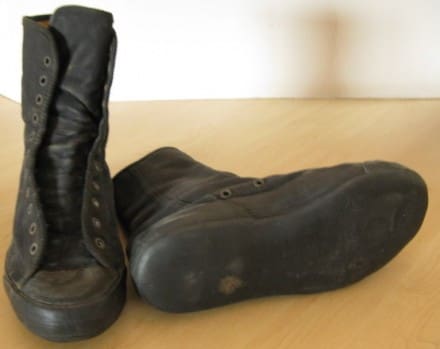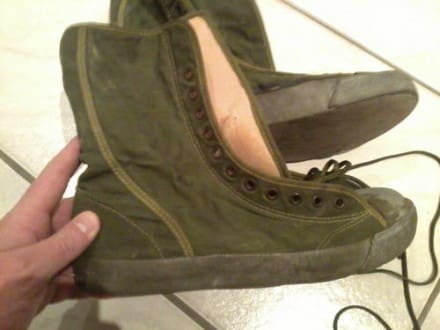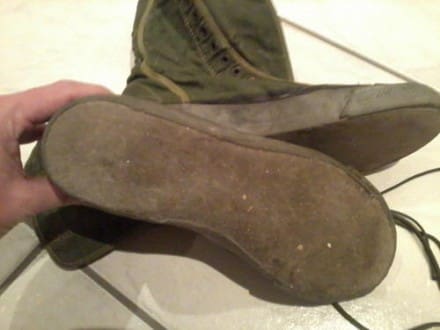While instructing our TÝR Group Combat Tracking Classes I am frequently asked about special footwear that is specifically produced to deceive a tracker or aid in counter tracking. Although there are many ways that a soldier can attempt to deceive a tracker one example I give them are boots that were produced during the South African Border War from 1966 to 1989. To keep from being detected by their enemy, some South African and South West African special operations were issued boots designed to deceive the enemy or villagers who might come in contact with their tracks.
These boots were produced with smooth soles so when impressions were made in the soft South African soil the footprint impressions would appear older than what they actually were. However depending on terrain and weather, these boots could either be an advantage or a disadvantage based on the smooth sole, especially in wet or humid environments.
By John Hurth, President of TÝR Group LLC and author of “Combat Tracking Guide” published by Stackpole Books.
Tags: John Hurth, TYR Group LLC





Hands down, the coolest Chuck Taylors I’ve ever seen. 😉
Where can I get a pair of the olive ones ?
MAC-V SOG tried a similar solution in Vietnam. It had actual imprint of a foot as I recall. Don’t think it was very successful.
Correct, a jungle boot with a bare human foot instead of the standard sole.
“Footprint” boots developed by Natick Labs. I went to school in a town nearby, and my high school class got a tour in the early ’80s. They had the boots on display. As I recall, they said they were ineffective because the average GI weighed much more than any VC, making the footprints too deep.
http://news.google.com/newspapers?nid=2199&dat=19820724&id=4qkyAAAAIBAJ&sjid=IOgFAAAAIBAJ&pg=6623,3757469
I would have molded in some toes and a heel to make the tracker think you were barefoot…
You’d think that a smooth but otherwise obviously fresh boot print would eventually come to be a sign that special operations troops where in the area; I mean once they captured a pair and disseminated the intelligence it would be a serious problem.
I’m assuming people have thought of this, but what about rubber soles that lock into the treads of boots? Let’s say a panama sole, something commonly used, and an injection molded rubber piece that locks in has a flat surface or a foot print on the bottom, kind of like the rubber feet used by the OSS in WW2 that strapped onto the bottoms of shoes. Could this suffice in bringing the counter tracking ability to the mainstream?
Basically, a jungle boot crossed with a moccasin.
Russel mocasins are offered with an over moulded vibram sole similar to these. Another interesting attempt were the WWII boot nets issued to comandos. I think the trouble with all of these are that on soft ground they just leave a smooth full foot outline which is fairly uncommon, in the end making a unique track that stands out against others. They do tend to be quiter and turn over less debris though. I have a pair of bellville mini-mils that are pretty close to smooth ,in sand they don’t leave any real pattern inside the print.
Cool boots , wish there was a run in the works!
The purpose of these boots is to leave as minimal a track as possible, unlike the deep and distinctive treads of most hiking or military boots. This makes it harder to track, and in addition the track will not last as long as those made by normal boot treads. Plopping a human foot tread onto boots like this would only make a bigger track that would be easier to follow…
A guy I worked with was in SWAPOL Koevoet and he told me the Angolans used to attach their boot soles backwards to try and throw off the trackers, but the bushmen could read them anyway.
If I have my history right (courtesy of Freddy Acuna and others teaching at TTOS back in the day), project b-52 specifically came up with a number of counter tracking measures, like foot imprint boots and some TTPs for movement, etc. It was discovered that the foot boots still left a toe off mark from a area of the boot molded normally, and gave the imprint away.
Another solution was to drop duffles or whatever full of USGI jungles into a target area, knowing locals would pick them up and wear them. Track saturation worked for awhile until the enemy started killing and maiming everyone wearing USGI boots.
Back and forth.
Osuna…man I’m slipping today.
Freddy would be disappointed, so I’ll use the proper name. Point of termination.
I have first hand experience hunting with a retired SA-army tracker. Told me he lived almost four years with the west African bushmen. He was old when I hunted with him, but his skills were fresh. Nothing got past this guy. I say all that to say this, the boots in question wouldn’t fool a tracker that worked at the level this man demonstrated. They Could however slow him down, and force him to double check, giving you precious time to escape or evade those following you. So in all, I believe these boots would have worked well for their intended purpose. Thus endeth the sermon.
The Rhodesians originated the concept (the black boots are Rhodesian and were produced in the 1970s, green were South African and were 1980s production). The South African and SWA Special Forces also issued fabric over-boots with leather soles, boots with tire pattern soles (to mimic homemade footwear) and boot soles that could be attached and removed. The smooth sole boots were supposed to be harder to track (as noted). The other devices were used to change your footwear (and thus tracks) at water holes or areas of high traffic so the trackers would lose the track of the team. The smooth sole boots were somewhat unpopular because having no tread they made it easier for the wearer to slip and fall.
Kind of reminds me of the novelty dog footprint shoes from japan, designed to make it look like a dog walking in the area. It would fool an untrained person, but definitely not a tracker.
Very interesting.
While we all obviously enjoy reading about new gear perhaps some more articles like this regarding the kit from the past that was the precursor to todays ‘tactical’ kit would be good?
I agree. We pop them in every once in awhile.